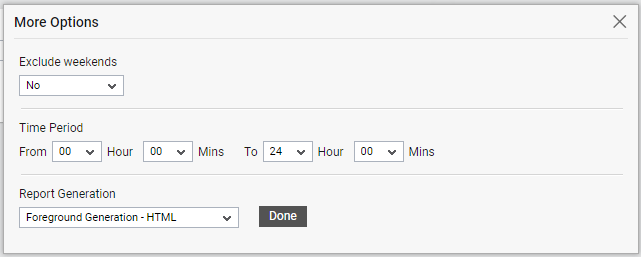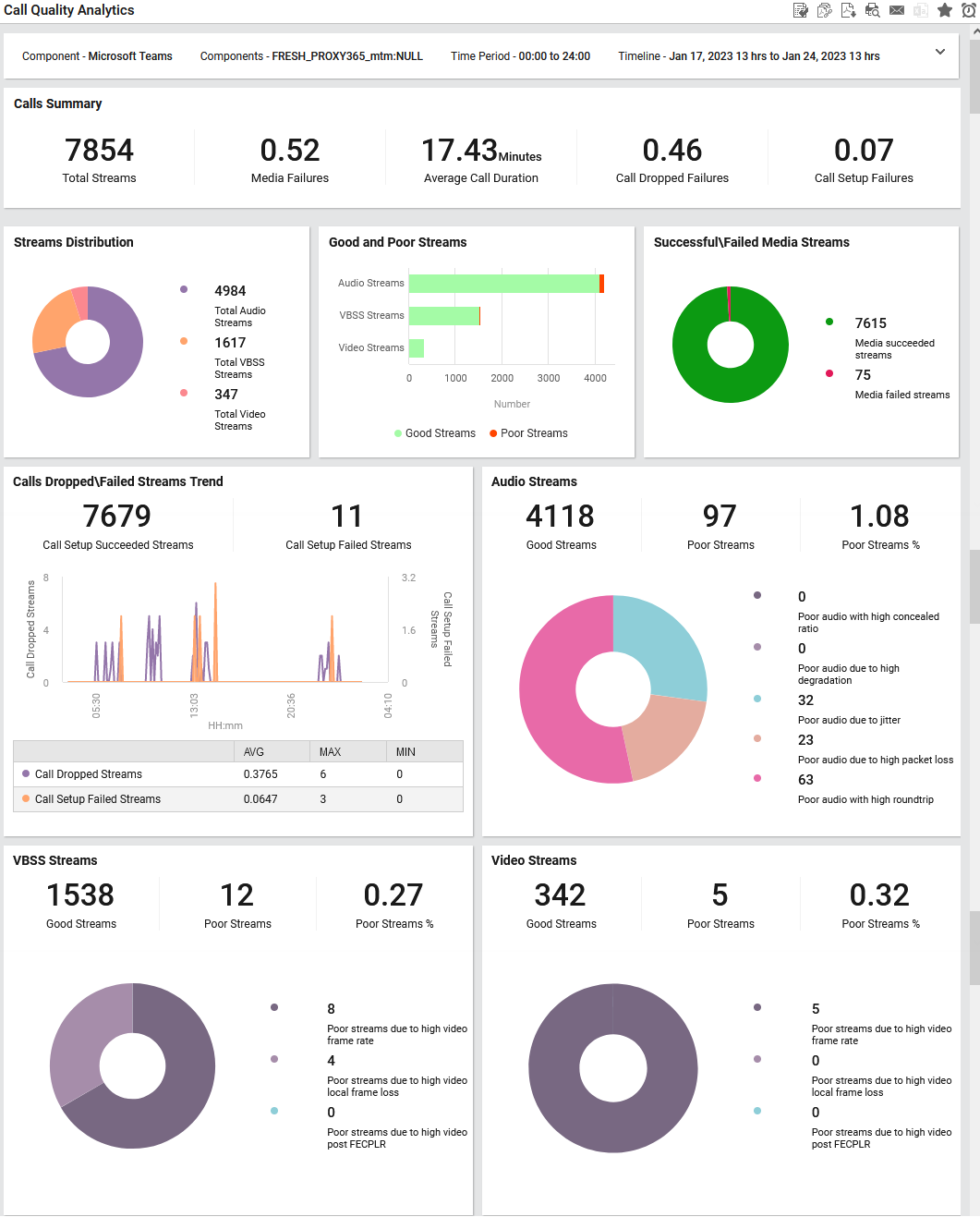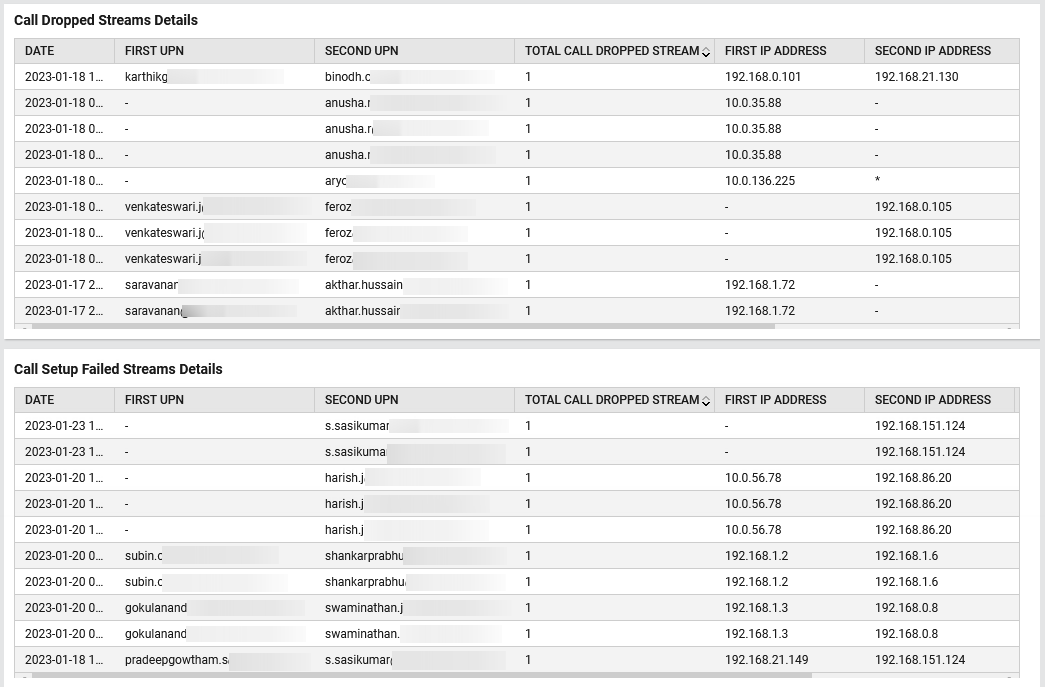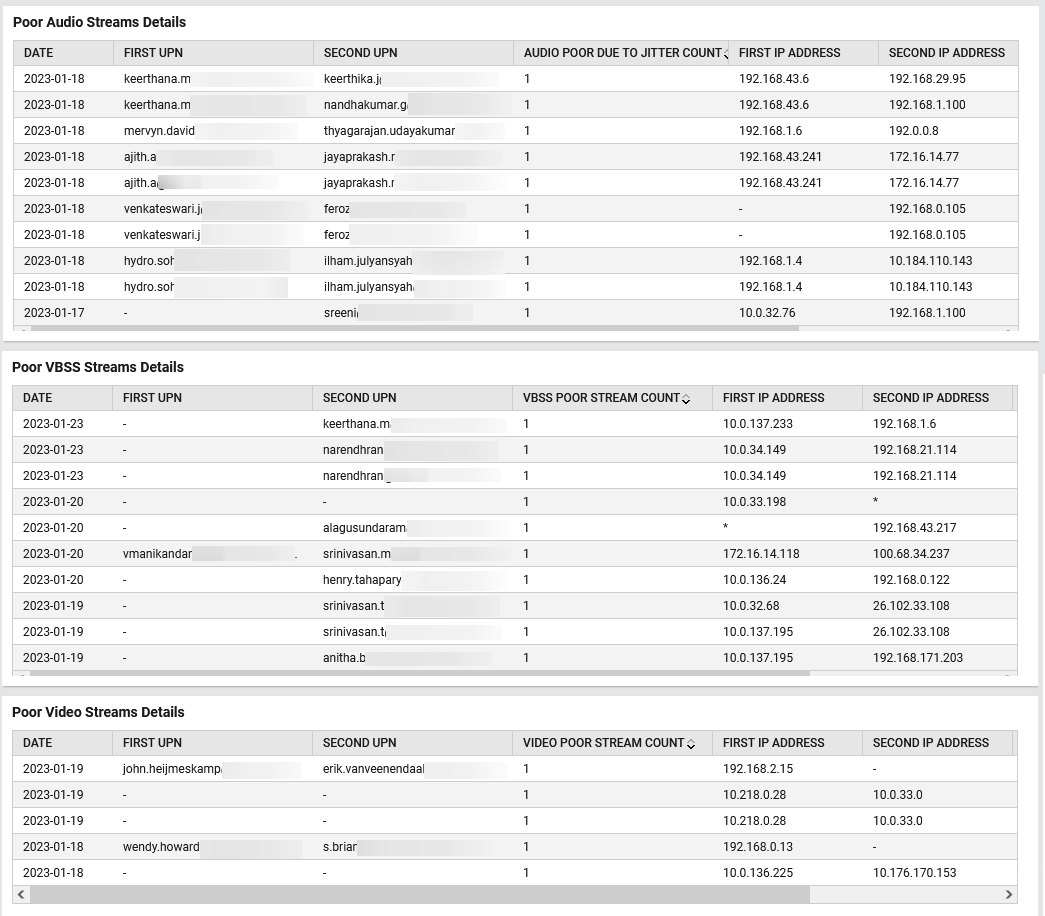Microsoft Teams - Call Quality Analytics Report
The Call Quality Analytics report offered by eG Enterprise helps administrators historically analyze the quality of calls handled by Microsoft Teams, so that they can determine the following:
-
Did calls consistently fail? If so, what were the common causes of the failure – call drops? incorrect call setup? media failures?
-
Were audio / video / VBSS streams unhealthy during the given period? What frequently caused the quality of the streams to degrade?
-
Were calls consistently slow?
With the help of these analytics, administrators can understand why user experience with Teams calls is poor, and what they should do to deliver a superlative experience to users.
To generate this report, do the following:
-
Login to eG Reporter.
-
Follow the menu sequence: REPORTS BY FUNCTION -> Domain-specific Reports -> Office 365 Monitoring -> Microsoft Teams -> Call Quality Analytics
-
Figure 1 will then appear.

-
Using this report, you can engage in user experience analysis on Microsoft Teams application that is part of a zone/segment/service. Indicate your choice by picking the one of the following options from the Analyze by list.
- Component: If the Component option is chosen from the Analyze by list, then all components of the chosen Component Type will be listed in the Component list box. From this list box, select the components for which the report is to be generated. If the Component list consists of too many components, then viewing all the components and selecting the ones you need for report generation could require endless scrolling. To avoid this, you can click the
 button next to the Component list. The COMPONENTS pop up window will then appear using which you can view almost all the components in a single interface and select the ones for which the report is to be generated.
button next to the Component list. The COMPONENTS pop up window will then appear using which you can view almost all the components in a single interface and select the ones for which the report is to be generated. - Zone: If the Zone option is chosen from the Analysis by list, then you would be required to select the Zone for which the report is to be generated. In addition, you will also have to indicate whether the report needs to include even those components that are included in the sub-zones of the chosen zone. If this is the case, you will have to set the Include sub-zones flag to Yes.
- Service: Select this option if the components for which a report is to be generated are involved in the delivery of a business service. Then, select a Service.
- Segment: Choose this option if the virtual hosts to be evaluated are part of a segment. Then, pick a Segment for analysis.
- Component: If the Component option is chosen from the Analyze by list, then all components of the chosen Component Type will be listed in the Component list box. From this list box, select the components for which the report is to be generated. If the Component list consists of too many components, then viewing all the components and selecting the ones you need for report generation could require endless scrolling. To avoid this, you can click the
-
Next, select the Component Type for which the report is to be generated.
-
The Components list will then be populated with the components that belong to the chosen Component Type. Select a component of your choice from this list.
-
Provide a report Timeline. You can either select a fixed timeline such as 1 hour, 2 days, etc., or choose the Any option from the Timeline list, and then provide a From and To date/time for report generation.
Note:
For every user registered with the eG Enterprise system, the administrator can indicate the maximum timeline for which that user can generate a report. Once the maximum timeline is set for a user, then, whenever that user logs into eG Reporter and attempts to generate a report, the Timeline list box in the report page will display options according to the maximum timeline setting of that user. For instance, if a user can generate a report for a maximum period of 3 days only, then 3 days will be the highest option displayed in the Timeline list - i.e., 3 days will be the last option in the fixed Timeline list. Similarly, if the user chooses the Any option from the Timeline list and proceeds to provide a start date and end date for report generation using the From and To specifications, eG Enterprise will first check if the user's Timeline specification conforms to his/her maximum timeline setting. If not, report generation will fail. For instance, for a user who is allowed to generate reports spanning over a maximum period of 3 days only, the difference between the From and To dates should never be over 3 days. If it is, then, upon clicking the Run Report button a message box will appear, prompting the user to change the From and To specification.
-
In addition to the settings discussed above, this report comes with a set of default specifications. These settings are hidden by default. If you do not want to disturb these default settings, then you can proceed to generate the report by clicking the Run Report button soon after you pick a Measure. However, if you want to view and then alter these settings (if required), click on the
 icon. The default settings will then appear in the MORE OPTIONS drop down window (see Figure 2). The steps below discuss each of these settings and how they can be customized.
icon. The default settings will then appear in the MORE OPTIONS drop down window (see Figure 2). The steps below discuss each of these settings and how they can be customized.
Figure 2 : The default settings for generating the Call Quality Analytics report
-
If the timeline specified for the report needs to exclude the data collected during the Weekends, then set Exclude weekends to Yes. If not, select No.
Note:
By default, the weekend constitutes Saturday and Sunday. To override this default setting, do the following:
- Edit the eg_report.ini file in the <EG_INSTALL_DIR>\manager\config directory.
- In the [RUM_REPOTRS] section of the file, the EXCLUDE_WEEKEND parameter is set to Saturday, Sunday by default. You can modify this by setting the EXCLUDE_WEEKEND parameter to a comma-separated list of other days of the week - say Friday, Saturday.
- Save the file after making the required changes.
-
Next, specify the start time and end time for report generation against the Time period field.
-
In large environments, reports generated using months of data can take a long time to complete. Administrators now have the option of generating reports on-line or in the background. When a report is scheduled for background generation, administrators can proceed with their other monitoring, diagnosis, and reporting tasks, while the eG manager is processing the report. This saves the administrator valuable time. To schedule background processing of a report, select the Background Save - PDF option or Background Save - CSV from the Report Generation list. In this case, a Report Name text box will appear, where you would have to provide the name with which the report is to be saved in the background. To process reports in the foreground, select the Foreground Generation - HTML option from this list.
Note:
- The Report Generation list will appear only if the EnableBackgroundReport flag in the [BACKGROUND_PROCESS] section of the eg_report.ini file (in the [EG_INSTALL_DIR]\manager\config directory) is set to Yes.
- The default selection in the Report Generation list will change according to the Timeline specified for the report. If the Timeline set is greater than or equal to the number of days specified against the MinDurationForReport parameter in the [BACKGROUND_PROCESS] section of the eg_report.ini file, then the default selection in the Report Generation list will be Background. On the other hand, if the Timeline set for the report is lesser than the value of the MinDurationForReport parameter, then the default selection in the Report Generation list will be Foreground. This is because, the MinDurationForReport setting governs when reports are to be processed in the background. By default, this parameter is set to 2 weeks - this indicates that by default, reports with a timeline of 2 weeks and above will be processed in the background.
-
Click the Done button if any changes were made to the More Options drop down window.
-
Finally, click the Run Report button to generate the report.
-
If the Report type is Foreground Generation - HTML, then Figure 3 will appear as soon as you click the Run Report button.

Figure 3 : The generated Call Quality Analytics report
The generated report (see Figure 3) contains the following sections:
-
The Calls Summary section reveals the overall count of audio/video/VBSS streams over the chosen time period. The percentage of media failures, call dropped failures and call set up failures help administrators figure out the overall experience of the users wth respect to call quality. The average call duration helps administrators rate the user experience on Microsoft Teams in the chosen time period.
-
The Streams Distribution doughnut chart helps you to figure out the count of audio streams, VBSS streams and video streams initaited by the users on Microsoft Teams over a chosen time period. This helps administrators identify the type of stream that is most widely used by the users for communication - is it audio streams? or video streams? or VBSS streams?
-
The Good and Poor Streams bar graph helps you in understanding the count of good and poor audio/video/VBSS streams reported in the chosen time period. By merely looking at this graph, you canfigure out the type of stream that contributed to maximum number of poor streams over a chosen time period.
-
The Successful\Failed Media Streams doughnut chart reveals the count of successful/failed media streams during the chosen time period. By analyzing this chart, administrators can figure out if media failure was the primary reason for poor user experience on Microsoft Teams.
-
The Calls Dropped\Failed Streams Trend section reveals the count of Call setup succeeded streams and the count of call setup failed streams in the chosen time period. Further the graph reveals the count of calls that were dropped due to the non-termination of media path normally and the count of calls that failed due to non-establishment of media path between the endpoints(users) over the chosen time period. Using this trend graph, administrators can identify the exact time at which call drops/call setup failures were at its peak. This will help administrators look back at that time to analyze the real reason behind such failures.
-
The Audio Streams section reveals the count of audio streams that were classfied as Good, the count and percentage of audio streams that were classified as Poor during the chosen time period. Further, the doughnut chart helps administrators analyze at a single glance on the reason behind the audio streams being classified as poor - is it due to high roundtrip? or high packet loss? or jitter? or high degradation? or high concealed ratio?
-
The VBSS Streams section reveals the count of VBSS streams that were classfied as Good, the count and percentage of VBSS streams that were classified as Poor during the chosen time period. Further, the doughnut chart helps administrators analyze at a single glance on the reason behind the VBSS streams being classified as poor - is it due to high video frame rate? or high video local frame loss? or high video post FECPLR?
-
The Video Streams section reveals the count of VBSS streams that were classfied as Good, the count and percentage of VBSS streams that were classified as Poor during the chosen time period. Further, the doughnut chart helps administrators analyze at a single glance on the reason behind the VBSS streams being classified as poor - is it due to high video frame rate? or high video local frame loss? or high video post FECPLR?
-
The Call Dropped Streams Details section (see Figure 4) helps you to identify the users who encountered frequent call drop issues and the count of calls that were dropped abruptly during the chosen time period. This will help administrators pinpoint the exact user whose user experience was poor/degrading during the chosen time period.
-
The Call Setup Failed Streams Details section (see Figure 4) helps you to identify number of streams where media path could not be established between the endpoints at the start of the call during the chosen time period. This report will pinpoint the exact user who has been experiencing issues while establising the media path between the endpoints over a period of time.

Figure 4 : The Call Dropped Streams Details and Call Setup Failed Streams Details sections
-
The Poor Audio Streams Details, Poor VBSS Streams Details and Poor Video Streams Details sections (see Figure 5) helps you in identifying the users involved in audio/video/VBSS streams that were classified as poor. By analyzing these sections, administrators can rate the experience of the users over a period of time and also initiate remedial measures to improve the user experience of those users whose calls were classified as poor.

Figure 5 : The sections that reveal the users with poor audio/video/VBSS streams
-



